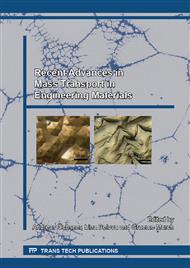p.73
p.83
p.91
p.101
p.107
p.117
p.135
p.149
p.157
Microstructure and Mechanical Properties of Directionally Solidified Unmodified and Ni-Modified Sn-0.7wt%Cu Lead-Free Solder Alloy
Abstract:
Lead containing solders (SnPb eutectic alloys) are widely used in electronic devices due to their good mechanical properties and low manufacturing cost. However, two European Union regulations (Waste from Electrical and Electronic Equipment and Restriction of Hazardous Substances) banned the use of lead in electrical and electronic equipment because of the toxic effect on human health and the environment. Nowadays, it is particularly important to find replacements for Pb containing solder materials. In that respect, copper is used as an alloying element and the composition Sn-0.7wt%Cu is of particular interest. Small Ni additions can be interesting since they would be included into the composition of the commercial solder SN100 and can also avoid the presence of coarse and deleterious Cu6Sn5 particles for Sn-Cu alloys in the hypoeutectic range of compositions. In the present investigation, growth rate, cooling rate, interfacial heat transfer coefficient (hi), the scale of the microstructure and morphologies, ultimate tensile strength and elongation have been experimentally determined for Sn-0.7wt%Cu and Sn-0.7wt%Cu-0.1wt%Ni alloys solidified in a water-cooled vertical upward unidirectional solidification system. Further, interrelations of thermal parameters, microstructure and tensile properties may be established. A higher time-dependent hi profile was found for the Sn-0.7wt%Cu-0.1wt%Ni alloy which seems to indicate that a higher fluidity was obtained with small Ni addition. Higher fluidity values may characterize better physicochemical affinity between the melt and the mould surface. The modified Sn-Cu alloy propitiates higher ultimate tensile strength values to be obtained. This may be due to the prevalence of eutectic two-phase cells along the casting associated with fine Cu-rich particles close to the water-cooled surface.
Info:
Periodical:
Pages:
107-115
Citation:
Online since:
January 2013
Authors:
Price:
Сopyright:
© 2013 Trans Tech Publications Ltd. All Rights Reserved
Share:
Citation:


